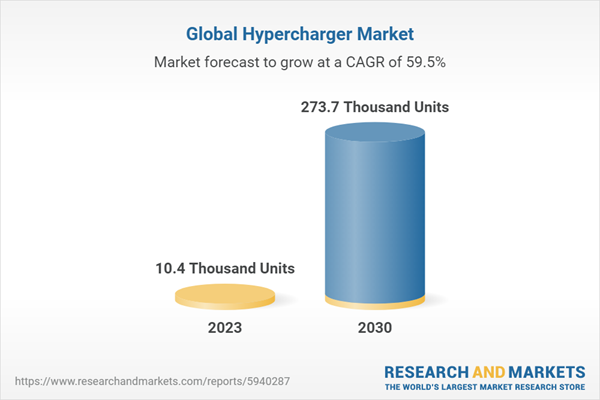The global Hypercharger market size is projected to grow from 10.4 Thousand Units in 2023 and projected to reach 273.7 Thousand Units by 2030, at a CAGR of 59.5%. Reducing electric vehicle (EV) prices is expected to drive increased demand in the Hypercharger market, primarily due to government support and technology advancements. Governments worldwide are incentivizing the adoption of electric vehicles through subsidies and tax benefits, making EVs more affordable for consumers. Additionally, continuous advancements in hypercharging technology are enhancing charging efficiency and reducing costs, further incentivizing consumers to opt for electric vehicles. The combination of government support and technological progress creates a favorable environment, fostering greater demand for hypercharging solutions in tandem with more affordable electric vehicles.
In-depth interviews were conducted with CEOs, marketing directors, other innovation and technology directors, and executives from various key organizations operating in the Hypercharger market. The break-up of the primaries is as follows:
This research report categorizes Hypercharger Market Port type (CCS, NACS, MCS and ChaoJi), Hypercharger compatible vehicle sales by vehicle type (Passenger Cars, Light Commercial Vehicles and Heavy Commercial Vehicles) and Region (Asia Pacific, Europe, North America).
The report will help the market leaders/new entrants in this market with information on the closest approximations of the revenue numbers for the overall Hypercharger market and the subsegments. This report will help stakeholders understand the competitive landscape and gain more insights to position their businesses better and to plan suitable go-to-market strategies. The report also helps stakeholders understand the market pulse and provides information on key market drivers, restraints, challenges, and opportunities.
ChaoJi is estimated to grow at a noticeable CAGR during the forecast period
Chaoji is anticipated to experience significant growth with a noticeable (CAGR) during the forecast period in the Hypercharger market. As a new charging standard, Chaoji stands out by enabling outputs of up to 900 kW, signifying a major leap forward in high-speed charging capabilities. Notably, ChaoJi is a collaborative effort between China and Japan, reflecting a cross-border partnership aimed at advancing hypercharging technology. The innovative features and international collaboration associated with Chaoji position it as a key segment in driving the growth of hypercharging solutions.North America Region shows high growth potential for Hypercharger market
The Hypercharger market in North America is experiencing significant growth, with Electrify America leading the way through strategic expansions. A key collaboration involves a partnership with TravelCenters of America (TA) to deploy around 1,000 DC fast chargers at 200 locations along major highways over five years. Electrify America, recognized for its expertise in designing and maintaining charging stations, extends its influence by integrating TA into its charging network. This collaboration, along with other industry partnerships, underscores Electrify America's pivotal role in expanding high-speed charging accessibility throughout North America.In-depth interviews were conducted with CEOs, marketing directors, other innovation and technology directors, and executives from various key organizations operating in the Hypercharger market. The break-up of the primaries is as follows:
- By Company Type: OEMs - 24%, Tier 1 - 67%, and Others - 9%
- By Designation: C Level Executives - 33%, Managers - 52%, and Others - 15%
- By Region: North America - 40%, Europe - 26%, and Asia Pacific - 34%
Research Coverage
The study covers the Hypercharger market across various segments. It aims at estimating the market size and future growth potential of this market across different segments such as vehicle type, port type, and region. The study also includes an in-depth competitive analysis of key market players, their company profiles, key observations related to recent developments.This research report categorizes Hypercharger Market Port type (CCS, NACS, MCS and ChaoJi), Hypercharger compatible vehicle sales by vehicle type (Passenger Cars, Light Commercial Vehicles and Heavy Commercial Vehicles) and Region (Asia Pacific, Europe, North America).
Reasons to buy this report:
The study also includes an in-depth competitive analysis of the key players in the market, along with their company profiles, key observations related to product and business offerings, recent developments, and key market strategies.The report will help the market leaders/new entrants in this market with information on the closest approximations of the revenue numbers for the overall Hypercharger market and the subsegments. This report will help stakeholders understand the competitive landscape and gain more insights to position their businesses better and to plan suitable go-to-market strategies. The report also helps stakeholders understand the market pulse and provides information on key market drivers, restraints, challenges, and opportunities.
The report provides insights on the following pointers:
- Analysis of key drivers (Increase in adoption of Electric Vehicles), restraints (DC Fast Chargers Can overload the grid), opportunities (Electric Truck and Bus Segment witnessing Developments Towards Hyper Charging), and challenges (Inadequate charging infrastructure in rural areas) influencing the growth of the Hypercharger market.
- Product Development/Innovation: Detailed insights on upcoming technologies, research & development activities, and new product & service launches in the Hypercharger market
- Market Development: Comprehensive information about lucrative markets - the report analyses the Hypercharger market across varied regions.
- Market Diversification: Exhaustive information about new products & services, untapped geographies, recent developments, and investments in the Hypercharger market
- Competitive Assessment: In-depth assessment of growth strategies, and service offerings of leading players like ABB (Switzerland), Electrify America (US), Heliox (Netherlands), Tritium (Australia) and IONITY (Germany), others in the Hypercharger market.
Table of Contents
1. Introduction
2. Research Methodology
5. Market Overview
6. Hypercharging Compatible Vehicle Sales by Vehicle Type
7. Hypercharger Market, by Port Type
8. Hypercharger Market, by Region
9. Competitive Landscape
Companies Mentioned
- ABB
- Electrify America
- Heliox
- Tritium
- IONITY
Table Information
| Report Attribute | Details |
|---|---|
| No. of Pages | 50 |
| Published | November 2023 |
| Forecast Period | 2023 - 2030 |
| Estimated Market Value in 2023 | 10.4 Thousand Units |
| Forecasted Market Value by 2030 | 273.7 Thousand Units |
| Compound Annual Growth Rate | 59.5% |
| Regions Covered | Global |
| No. of Companies Mentioned | 5 |









